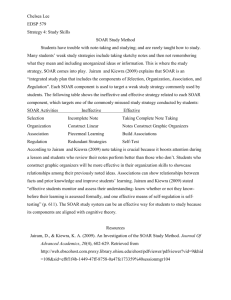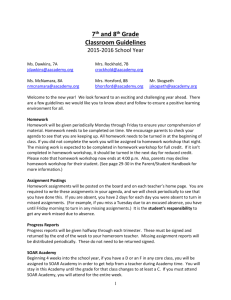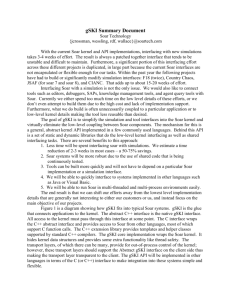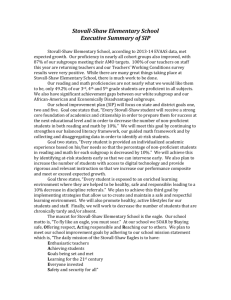Impact & Innovation Awards 2013
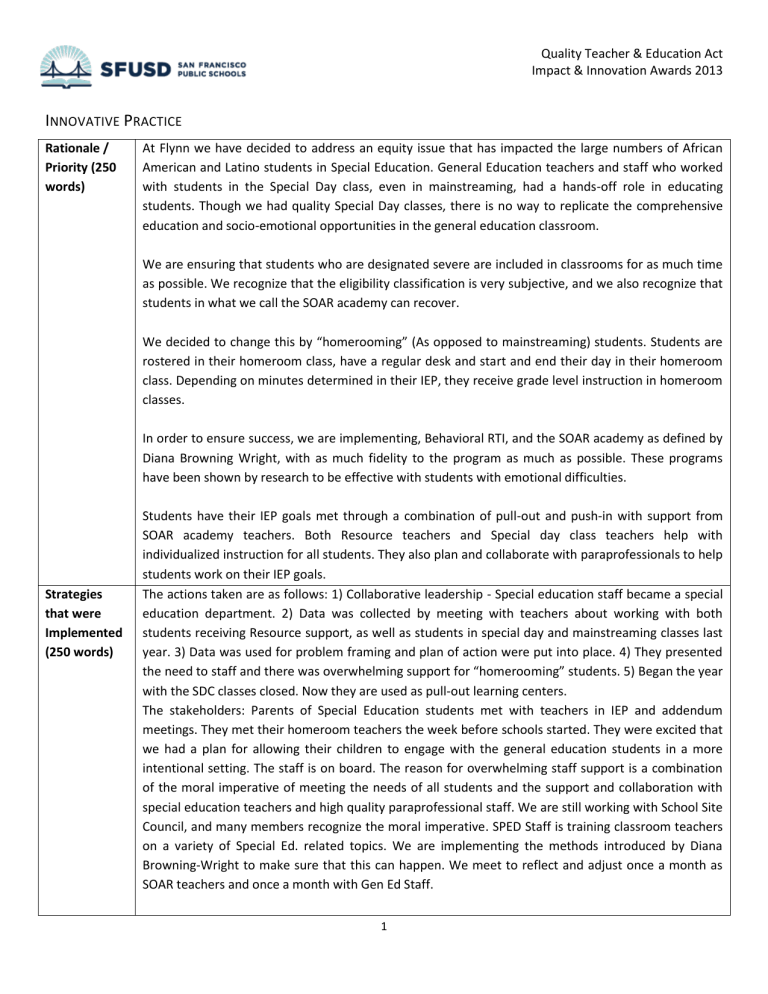
Quality Teacher & Education Act
Impact & Innovation Awards 2013
I NNOVATIVE P RACTICE
Rationale /
Priority (250 words)
Strategies that were
Implemented
(250 words)
At Flynn we have decided to address an equity issue that has impacted the large numbers of African
American and Latino students in Special Education. General Education teachers and staff who worked with students in the Special Day class, even in mainstreaming, had a hands-off role in educating students. Though we had quality Special Day classes, there is no way to replicate the comprehensive education and socio-emotional opportunities in the general education classroom.
We are ensuring that students who are designated severe are included in classrooms for as much time as possible. We recognize that the eligibility classification is very subjective, and we also recognize that students in what we call the SOAR academy can recover.
We decided to change this by “homerooming” (As opposed to mainstreaming) students. Students are rostered in their homeroom class, have a regular desk and start and end their day in their homeroom class. Depending on minutes determined in their IEP, they receive grade level instruction in homeroom classes.
In order to ensure success, we are implementing, Behavioral RTI, and the SOAR academy as defined by
Diana Browning Wright, with as much fidelity to the program as much as possible. These programs have been shown by research to be effective with students with emotional difficulties.
Students have their IEP goals met through a combination of pull-out and push-in with support from
SOAR academy teachers. Both Resource teachers and Special day class teachers help with individualized instruction for all students. They also plan and collaborate with paraprofessionals to help students work on their IEP goals.
The actions taken are as follows: 1) Collaborative leadership - Special education staff became a special education department. 2) Data was collected by meeting with teachers about working with both students receiving Resource support, as well as students in special day and mainstreaming classes last year. 3) Data was used for problem framing and plan of action were put into place. 4) They presented the need to staff and there was overwhelming support for “homerooming” students. 5) Began the year with the SDC classes closed. Now they are used as pull-out learning centers.
The stakeholders: Parents of Special Education students met with teachers in IEP and addendum meetings. They met their homeroom teachers the week before schools started. They were excited that we had a plan for allowing their children to engage with the general education students in a more intentional setting. The staff is on board. The reason for overwhelming staff support is a combination of the moral imperative of meeting the needs of all students and the support and collaboration with special education teachers and high quality paraprofessional staff. We are still working with School Site
Council, and many members recognize the moral imperative. SPED Staff is training classroom teachers on a variety of Special Ed. related topics. We are implementing the methods introduced by Diana
Browning-Wright to make sure that this can happen. We meet to reflect and adjust once a month as
SOAR teachers and once a month with Gen Ed Staff.
1
Demonstrated
Application &
Measurable
Outcomes
(400 words)
Quality Teacher & Education Act
Impact & Innovation Awards 2013
Implementation factors:
# people:
33
# hours:
20 hours per SPED
Cost estimate:
5000 for extended days and sub days
Other(s):
Admin, teachers, content specialist, community partnerships classroom teacher, as well as admin and some paraprofessional staff
The targeted groups are Special Education students, the majority of who are African American and
Latino. They have historically been marginalized. Now we are making sure they have a place in the classroom. These students mostly are eligible among other things for having severe emotional disturbances. We are making sure they recover.
The impact: All of our students in the SOAR academy have a homeroom classroom. Referrals and office calls for students in the SOAR academy are down. Bus referrals are down. Teachers are aware of trainings they can attend to work with students in the SOAR academy and are signing up for Second
Step and CPI in order to be better able to work with all students. Teachers understand the moral imperative of including all students in learning.
Teachers support the change. Teachers are aware of the need to receive training to work with all students. Teachers are realizing that adult actions can exacerbate escalation. Teachers are eager to receive more training on how to teach students in the SOAR academy. Teachers and SPED staff are collaborating with Gen. Ed. teachers.
We are providing opportunities for in house and outside Professional Development.
In Summary:
All students with Special Education designation are assigned to a homeroom class.
Special Education teachers have taken the leadership on this and have formed a special education department called the SOAR team.
Team met to plan this year, three days in 2012-2013, and one day in August. They presented at beginning of the year PD 2013-2014. Classroom teachers trained in building relationships, greeting, 5:1, using positive affective language. This expectation in principal’s expectations for all teachers.
All students, including students in Special Day Class are rostered in general education or bilingual classrooms. Students have desk and all materials, and are in all ways part of the class. Special education is seen as a service, not a placement.
Training follows Diana Browning-Wright model. Ongoing training for school staff on this model.
Teachers and school staff communicate with the community around the moral imperative, rationale,
2
Quality Teacher & Education Act
Impact & Innovation Awards 2013 research to support the effectiveness of the model and support that classrooms receive relating to this change.
Sharing Best
Practice (250 words)
I see this as a model for the district in that other schools with SED classes can address the needs of their students using this model. This is a model that works well with the Diana Browning-Wright strategies. Other schools can create similar SOAR academies. We have created a full inclusion model with much less paraprofessional staff than other schools. We are keeping students in the classroom and following the principles of Lease Restrictive Environment, keeping students out of SDC classes and private more restrictive institutions.
We have been encouraged to share this model by Diana Browning Wright, as well as some zone supervisors. Our model can be done with minimal expenditure. It does require collaboration between general education and Special Education staff, high quality teachers and paraprofessional stall.
3

